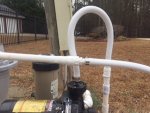The speed of a motor is determined by the frequency and number of poles and the slip.If a 220v motor is wired to 110, it will run at half speed.
A 2 pole motor runs at 3,600 rpm unloaded and about 3450 under load. The difference is caused by "slip".
A 4 pole motor runs at 1,800 rpm unloaded and about 1,725 loaded.
If the voltage is too low, slip will increase and cause the motor to run more slowly but it's not accurate to say that at half voltage the speed is half.
In this case, I think that it's just bad bearings from a leaky seal. The pump might have run dry but it might be due to a cheap seal. Cheap seals do not last very long. When replacing a pump seal, it pays to get the good quality ones.
I think that the pump is probably wired properly. It looks like it's wired for 230 and is getting 230.
The booster pump timer should be tied into the pump timer. If the booster can be turned on with the main pump off, then it's wired incorrectly.


